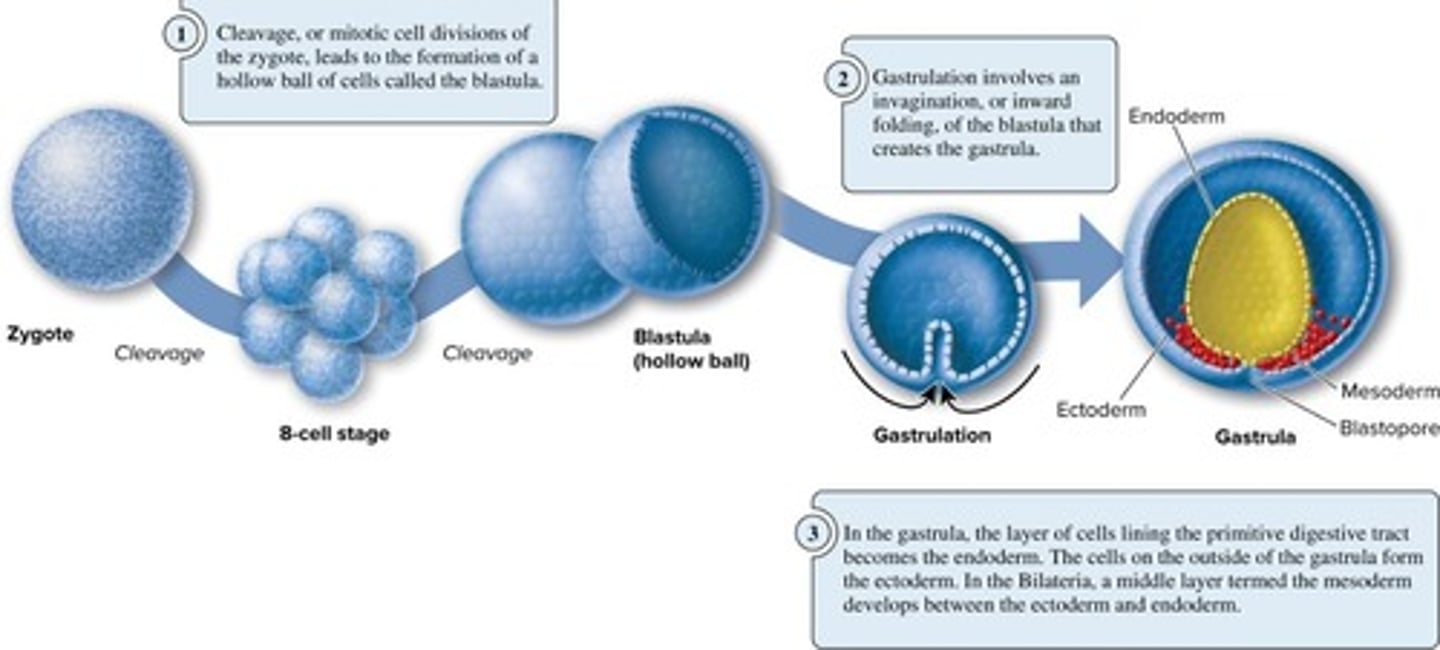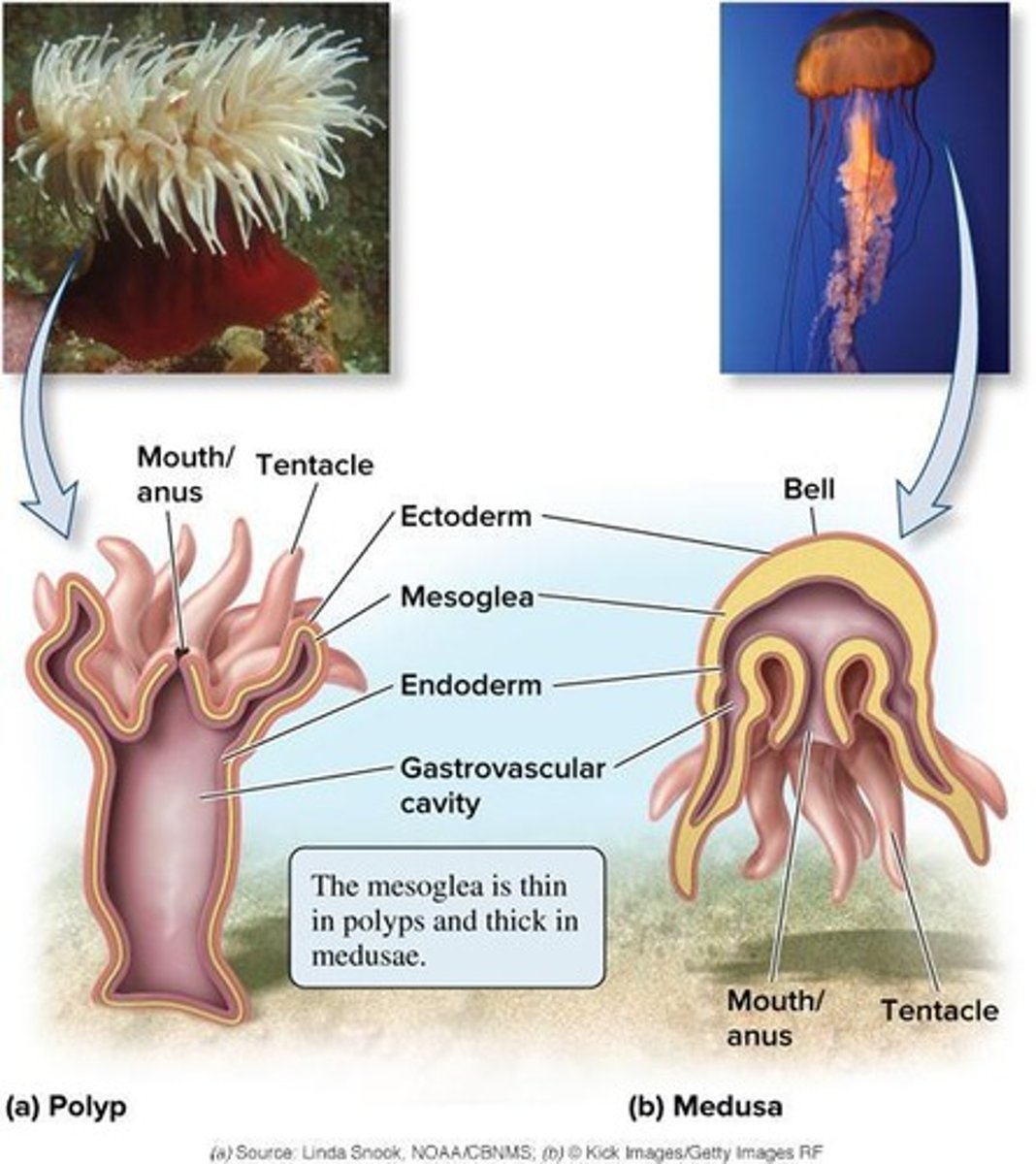Animal Evolution and Diversity: Invertebrates Overview
1/150
There's no tags or description
Looks like no tags are added yet.
Name | Mastery | Learn | Test | Matching | Spaced |
|---|
No study sessions yet.
151 Terms
Who is the instructor for Biol 191?
Dr. David Choate
What are the office hours for Dr. David Choate?
M/W 3-4 pm & Tu/Th 1-2+ pm or by appointment via Zoom.
What is the role of Alan Garcia in Biol 191?
Alan Garcia is the Supplemental Instruction leader providing virtual tutoring.
When are Alan Garcia's SI sessions?
Tu & Th 1:30 - 3:00 pm.
What is a key characteristic that distinguishes animals from other organisms?
Animals are multicellular and heterotrophic.
What is the significance of Hox genes in animals?
Hox genes function in patterning the body axis.

What type of reproduction is common among animals?
Sexual reproduction, involving small mobile sperm and larger eggs.
What are the two phases of fertilization in animals?
Internal fertilization (terrestrial species) and external fertilization (aquatic species).
What process forms layers that ultimately develop into tissues in embryonic development?
Cleavage and gastrulation.

What is the closest living relative of animals?
Choanoflagellates.
What do receptor tyrosine kinases (RTKs) indicate about animal evolution?
RTKs are found in all animals and choanoflagellates, suggesting a common ancestor.
What are the simplest animals mentioned in the notes?
Sponges.
What percentage of animal species are invertebrates?
Approximately 95%.
How is evolutionary success measured in animals?
By the number of species.
What is the most species-rich kingdom?
Animalia.
How many species are estimated to exist in the Animalia kingdom?
Over 1 million species.
What are the general characteristics of animals?
Multicellular, heterotrophic, internal digestion, motile, lack cell walls, and possess structural proteins.
What supports animal cells and allows communication between them?
Extracellular matrix (ECM) and cell junctions.
What is the significance of embryonic development in animals?
It involves the formation of tissues from embryonic layers.
What are the three domains of life mentioned?
Archaea, Bacteria, and Eukarya.
What is a notable feature of animal genomes?
Most animals possess Hox genes.
What is the evolutionary timeline for the origin of animals?
Animals evolved from protists around 600 million years ago.
What is the total number of species in the Kingdom Animalia?
Approximately 66,000 species.
What are the four major evolutionary trends in animal body plans?
Symmetry, Cephalization, Body cavity structure (Coeloms), and Segmentation.
What type of symmetry do Cnidarians exhibit?
Radial symmetry.

What is radial symmetry?
A circular arrangement of body parts around a central axis, allowing division into similar halves by any plane through the main axis.
What is bilateral symmetry?
A body plan that can be divided into right and left mirror images on only one plane, typically along the anterior-posterior midline.
Which animal phyla do not possess any kind of symmetry?
Porifera (sponges) do not possess symmetry.
How is bilateral symmetry correlated with cephalization?
Bilateral symmetry is associated with the concentration of sensory organs and nerve tissues at the anterior end, or head, which encounters the environment first.
What are the two types of germ layers in animals?
Triploblastic animals have three layers (ectoderm, mesoderm, endoderm), while diploblastic animals have two layers (ectoderm and endoderm).
What is the difference between protostomes and deuterostomes in terms of blastopore development?
In protostomes, the blastopore develops into the mouth; in deuterostomes, it develops into the anus.
What type of cleavage do protostomes exhibit?
Spiral cleavage that is determinate, meaning cell fate is determined early.
What type of cleavage do deuterostomes exhibit?
Radial cleavage that is indeterminate, allowing for the possibility of identical twins.
What is a coelom?
A fluid-filled body cavity that allows internal organs to expand and contract, provides room for offspring, and increases flexibility.
What is an acoelomate?
An organism that lacks a fluid-filled body cavity, with the space between the gut and body wall filled with cells.
What is a pseudocoelomate?
An organism with a body cavity that is a fluid-filled space in which internal organs are suspended, lined by mesoderm on only one side.
Which animals are examples of acoelomates?
Flatworms are examples of acoelomates.
Which animals are examples of pseudocoelomates?
Rotifers and nematodes are examples of pseudocoelomates.
What are the advantages of having a coelom?
It allows for the expansion and contraction of internal organs, provides space for reproductive systems, and increases the size and complexity of the organism.
What is the evolutionary significance of gastrulation?
Gastrulation leads to the formation of germ layers and the coelom, which are critical for the development of more complex body structures.
What is cephalization?
The concentration of sensory organs and nerve tissues at the anterior end of an organism.
What is the significance of bilateral symmetry in animal evolution?
It is associated with the development of a central nervous system and enhanced sensory perception.
Which group of animals exhibits radial symmetry as adults due to evolutionary regression?
Echinoderms exhibit radial symmetry as adults.
What is the role of the archenteron in embryonic development?
The archenteron is the rudimentary gut formed during gastrulation.
What is a coelomate?
An organism with a body cavity lined on both sides by mesoderm.
What is the peritoneum?
A layer of muscular tissue that lines the coelom and surrounds internal organs.
What is another term for coelomate?
Eucoelomate.
Give examples of coelomate animals.
Annelids, arthropods, and chordates.
What is segmentation in animals?
The repetition of body parts, allowing for greater strength, flexibility, and development of appendages.
What is the trend in circulation systems among animals?
The evolution from open to closed circulatory systems.
Describe an open circulatory system.
Blood flows through vessels and open spaces, bathing internal organs directly.
What is hemolymph?
The fluid in an open circulatory system, which has no distinction between blood and interstitial fluid.
Provide an example of an organism with an open circulatory system.
Crayfish or lobster.
Describe a closed circulatory system.
Blood is confined entirely to vessels, with capillaries as sites of exchange between blood and interstitial fluid.
Provide an example of an organism with a closed circulatory system.
Earthworm.
What are ctenophores?
The earliest-diverging animal lineage, also known as comb jellies.
What unique feature do ctenophores possess for locomotion?
They use cilia.
What reproductive strategy do ctenophores exhibit?
They are hermaphroditic, releasing gametes into the water.
What is a unique characteristic of ctenophores regarding light?
Nearly all exhibit bioluminescence.
What is the body plan of sponges?
Sponges lack true tissues and are multicellular, with different cell types performing various functions.
How do sponges defend themselves against predators?
Many sponges produce toxins.
What type of digestion do sponges use?
Intracellular digestion.
What are the two types of reproduction in sponges?
Sexual (most are hermaphrodites) and asexual (fragments or buds may form new sponges).
What are cnidarians?
A phylum that includes hydra, jellyfish, box jellies, sea anemones, and coral.
What are the two body forms of cnidarians?
A sessile polyp and a motile medusa.
What are cnidocytes?
Specialized stinging cells in cnidarians that function in defense or prey capture.
What do cnidocytes contain?
Nematocysts.
What are the two major clades of Protostomes?
The Ecdysozoa and the Lophotrochozoa.
What unique features do members of the Lophotrochozoa possess?
They possess a lophophore, a distinct larval stage called a trochophore, or share molecular similarities with other members.
What is a lophophore?
A feeding structure found in bryozoans, brachiopods, and rotifers.
What is a trochophore?
A swimming larval stage found in mollusks, annelids, and platyhelminthes.
What are the main characteristics of Phylum Platyhelminthes?
They are acoelomate, lack specialized respiratory or circulatory systems, have an incomplete digestive system, and can reproduce sexually or asexually.
What is the significance of the digestive system in Platyhelminthes?
It is incomplete, with one opening serving as both mouth and anus, and food is digested in a gastrovascular cavity.
Name the four classes of Platyhelminthes.
The common names of the four basic types include free-living predators and parasitic flatworms.
What is a unique reproductive feature of some flatworms?
Some can produce a large number of offspring; for example, an individual adult fluke can produce 360 million offspring.
What is the defining characteristic of Phylum Rotifera?
They have a pseudocoelom and a ciliated crown called a corona.
How do rotifers feed?
They create water currents with their corona to propel themselves and bring food toward their mouth.
What is the habitat and size of most rotifers?
They are mostly freshwater organisms and are microscopic, with around 2,200 species.
What do Bryozoa and Brachiopoda have in common?
Both possess a lophophore and a true coelom.
What are the characteristics of Bryozoans?
They are small colonial animals that are important reef builders.
What distinguishes Brachiopods from other marine organisms?
They are bottom-dwelling marine organisms with two shell halves, similar to clams.
What is the estimated number of living species in Phylum Mollusca?
There are over 100,000 living species of mollusks.
What are the major body sections of mollusks?
1. Muscular foot, 2. Visceral mass, 3. Mantle.
What types of organisms are included in the Mollusca phylum?
Snails, slugs, oysters, mussels, squid, and octopus.
How does environmental diversity relate to mollusk diversity?
The tremendous diversity of mollusk body plans is related to the diversity of their environments.
What is the function of the mantle in mollusks?
The mantle is a fold of skin over the visceral mass that secretes a shell in species that form shells.
What does the mantle cavity in mollusks house?
The mantle cavity houses gills.
What type of circulatory system do most mollusks have?
Most mollusks have an open circulatory system with a heart that pumps hemolymph through vessels and into cavities called sinuses.
What is a radula in mollusks?
A radula is a unique tongue-like organ that may be present in the mouth of mollusks.
What is the typical reproductive strategy of mollusks?
Most mollusks have separate sexes, though some are hermaphroditic.
How do mollusks typically fertilize their gametes?
Gametes are usually released into the water for external fertilization.
What innovation allows some snails to colonize land?
Internal fertilization is a critical innovation that allows some snails to colonize land.
What are Cephalopods and how many species exist?
Cephalopods are the most complex mollusks, with 780 species, and are marine predators.
What type of circulatory system do Cephalopods have?
Cephalopods have a closed circulatory system where blood flows entirely within a series of vessels.
What are the advantages of segmentation in annelids?
1. Repetition provides backup for body components. 2. Minimizes distortion during muscle contraction for effective locomotion. 3. Some segments can be specialized.
How do annelids reproduce sexually?
Sexual reproduction in annelids involves two individuals exchanging sperm via internal fertilization.
What is a method of asexual reproduction in some annelids?
Some species reproduce asexually by fission, where the posterior part of the body breaks off to form a new individual.
What type of transport system do annelids have?
Annelids have a double transport system where both the circulatory system and coelomic fluid carry nutrients, wastes, and respiratory gases.
What type of circulatory system do annelids possess?
Annelids have a closed circulatory system with dorsal and ventral vessels connected by pairs of pulsating vessels.
How do annelids respire?
Respiration occurs directly through the permeable skin surface, which restricts annelids to moist environments.